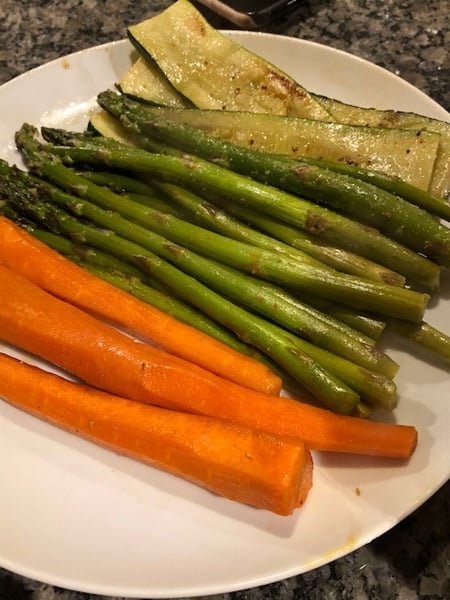Micronutrients Part 1: Vitamins

When it comes to diet and nutrition, we hear a lot lately about macronutrients, whether it's around diets like keto or low fat that look to limit a certain macro, or my preferred approach of consuming them all in a balanced diet. While managing your calories and macronutrients is far and away the most important factor to control - whether your goal is to lose body fat or gain muscle, ignoring the role that micronutrients play in the body would be foolish and if neglected long enough, extremely unhealthy.
Macronutrients are measured in grams, where as vitamins are measured in micrograms or IU, for international unit (2/3 of a milligram). Minerals are usually measured in milligrams. This post is part one of two that will go into detail about the different vitamins that our bodies require to function optimally. Next month's part two will tackle minerals.
Vitamins
Different vitamins have unique purposes, but they all aid in some way or another in maintaining a healthily functioning metabolism. Remember that metabolism quite literally means the sum of all chemical reactions that occur within our body, so vitamins are used to aid the chemical reactions and keep processes moving. We use the term “coenzyme” to describe them. The term “enzyme” literally means: “a substance produced by a living organism which acts as a catalyst to bring about a specific biochemical reaction.” Therefore, vitamins act as sort of the lubricant that keeps the wheels spinning in our bodies, which makes sense as to why issues may arise if someone is deficient in certain vitamins.

Vitamins are classified as either fat soluble or water soluble, based on which substance they dissolve in. If we are getting adequate amounts of each vitamin, our body will work as it is meant to. If we are deficient in a vitamin, certain health issues can arise. Too much of a certain vitamin can also pose problems, however in nearly all cases, vitamin toxicity stems from consuming too much in supplement form, as they are digested far quicker than when consumed in foods. There are also different recommended daily allowances for vitamins if you are an infant, child, or pregnant, just as there are for calories/macronutrients. Something to note is that if you’re lacking in a certain vitamin on a few days here and there you’ll be just fine, as most problems are due to chronic deficiencies. On the flip side, if you consistently consume your recommended daily amount, you’ll probably feel better overall than someone who’s a lot less consistent (all other things being equal).

Fat Soluble Vitamins
These vitamins all dissolve in fat, therefore can be stored in fat stores as well as the liver for later use.
Vitamin A
- Deficiency: eyesight won’t be as good as it could be in the dark, dry skin
- Common sources: carrots, pumpkin, sweet potatoes, leafy greens, bell peppers, eggs, peaches, beef
Vitamin D
- Deficiency: deformed bone growth, soft teeth, and stunted growth in children. Softened bones, tooth decay, and spontaneous bone fractures in adults.
- Common sources: sunlight, mushrooms, fatty fish, fortified foods (commonly dairy), eggs
Vitamin E
- Deficiency: Rare except in cases of severe malnutrition. May have certain anti-aging properties with regards to skin.
- Common sources: leafy greens, olives, blueberries, tomatoes, avocados, most nuts and seeds
Vitamin K
- Deficiency: Anemia (reduction in red blood cells) which can lead to overall weakness, fatigue, and greater tendency to bleed.
- Common sources: leafy greens, broccoli, parsley, asparagus, Brussels sprouts, green beans, peas
Water Soluble Vitamins
As the vitamins all dissolve in water, they must be consumed more regularly than fat soluble vitamins as we do not have a water “storage site.”
Vitamin C
- Deficiency: bruising, lethargy, cavities, gum disease, dry hair and skin, dry eyes, delayed wound healing, joint pain, bone fragility, and if deficient for long periods of time, scurvy.
- Common sources: bell peppers, guava, citrus fruits, kiwi, strawberries, Brussels sprouts, cantaloupe, papaya, pineapple, cauliflower, kale, sweet potatoes
- Note: There is very little evidence that taking extra doses of vitamin C will actually help fight a cold, especially if you have already been consuming adequate amounts of it.
B Vitamins
There are 8 different B vitamins that are found in a wide variety of foods. They play a big role in carbohydrate and fat metabolism by aiding in those pathways. Many people claim B vitamins “give you energy”, which is not exactly true; they are more so allowing you to pull energy in the form of ATP from consumed food better. Most people get adequate amounts of them in their diet, but a few populations may want to supplement with them (usually in the form a B complex vitamin, which contains all 8). Pregnant and breastfeeding women will need a higher intake of B vitamins, as they need to support their own metabolisms as well as their developing baby. Older adults (50+) also begin to lose their ability to metabolize vitamin B12 due to a reduction of stomach bile production, which is needed to release B12 from food. Anyone following a plant-based diet will also need to supplement B12, as it is only naturally found in animal sources.
- Common sources: salmon, leafy greens, organ meats, dairy products, eggs, beef, pork, shellfish, trout, legumes, sunflower seeds, poultry, fortified cereals
For the most part, if you are eating a diet consisting of a wide variety of minimally processed foods, you are most likely getting adequate vitamins in your diet. The foods listed as common sources are anything from all encompassing, and you’ll also note that certain foods like leafy greens and eggs are high in many different vitamins, therefore should be a staple in most people's diets. One point that I have stressed in my previous articles is that we often times think that “nutritious” or “healthy” foods are synonymous with weight loss, when in reality they just mean “high in micronutrients.” Many of the foods listed above are fruits and veggies, so eating a lot of them will probably boost your health, but in the case of some of the meats, nuts, and seeds, eating a lot will come with a lot of calories, so be careful not to overdo it.

Stay tuned for part two on this topic, which will go over minerals and their function in the body.
Have you heard? The Chopping Block has a new Registered Dietician Nutritionist, Amy Klassman who will soon be teaching a demonstration class called The Non-Diet Diet among others. Check it out - there are only 4 spots left in the July session!

